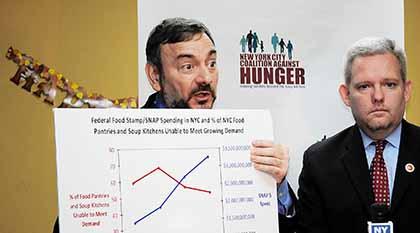By Joe Anuta
An increasing number of Queens residents could not afford food this year, even as many food centers in the borough had to cut back services, according to a survey released at a food center in Long Island City last week.
Nearly 90 percent of food pantries, soup kitchens and other emergency food centers in the borough fed more people this year than last. But about half of food centers received less food and money from the government, according to the survey of these outlets by the New York Coalition Against Hunger.
The drop in funds and food forced the centers to cut hours, portion sizes or turn away residents seeking food, said Joel Berg, executive director of the coalition, who pointed out that combating hunger in the borough poses unique problems.
“Poverty in Queens is relatively new,” Berg said, speaking at the Aids Center of Queens County at 42-57 Hunter St. “There is a bit of denial since Queens is perceived as middle class.”
Because the borough has not traditionally had a large poverty problem, Berg said neighborhoods have had less time to set up networks of social services. In addition, the lack of an extensive public transportation network has hindered many residents’ access to food centers.
“A lot of people walked here today,” Berg said.
Despite these obstacles, the emergency food centers reported not only an increase in numbers, but also in the types of people knocking on their doors.
All of the centers reported an increase in families with children and said they believe that demand will increase greatly in the next six months.
Citywide, the number of residents who use emergency food centers increased nearly 7 percent on top of a 20 percent increase in 2009, according to the coalition.
The Queens survey was released a day after another study by city agencies that reported an 11 percent increase in the number of New Yorkers who used food stamps this year, following a record increase of 22 percent in 2009. The food stamp report was released by the city Human Resource Association and Department of Social Services.
But the numbers would have been worse, according to Berg, if the government stimulus package had not been in place.
That is why Berg has called on the government to keep funding social safety net programs, along with instituting a number of policy changes.
First, he recommended ending child hunger through policies such as serving more food at school and funding the Women, Infants and Children Program.
Berg also called for an increase in the minimum wage.
In addition, he outlined plans to increase participation in food assistance programs by simplifying the application process.
Reach reporter Joe Anuta by e-mail at januta@cnglocal.com or by phone at 718-260-4566.


































